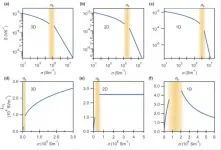(Press-News.org) HOUSTON - Researchers at The University of Texas MD Anderson Cancer Center have discovered that mutant KRAS and p53, the most frequently mutated genes in pancreatic cancer, interact through the CREB1 protein to promote metastasis and tumor growth. Blocking CREB1 in preclinical models reversed these effects and reduced metastases, suggesting an important new therapeutic target for the deadly cancer.
The findings were published today in Cancer Discovery and presented at the virtual American Association for Cancer Research (AACR) Annual Meeting 2021 by Michael Kim, M.D., assistant professor of Surgical Oncology and Genetics.
"To our knowledge, this is the first study to show how these two major genetic drivers work together to promote tumor growth and metastasis," Kim said. "We learned that signaling downstream of mutant KRAS directly promotes mutant p53 activity. This discovery provides not only a new therapeutic target but unveils a vast transcriptional network that is activated downstream of these mutant proteins."
Mutations in KRAS and TP53, the two most frequently mutated genes in all human cancers, co-occur in roughly 70% of patients with pancreatic cancer. Mutant KRAS, found in 95% of pancreatic cancers, leads to an activated protein that aberrantly triggers many downstream signaling pathways. Mutant TP53 results in the loss of the proteins' tumor suppressor function, leaving the mutant protein capable of fueling additional oncogenic processes, such as metastasis.
Unfortunately, no current therapies are able to block the mutant forms of KRAS or p53 prevalent in pancreatic cancer, so there is a need to identify common, alternative therapeutic targets downstream of these proteins that could lead to more effective treatment regimens for pancreatic cancer, Kim explained.
To learn how mutant KRAS and p53 might be interacting, Kim's team of researchers collaborated with Gigi Lozano, Ph.D., chair of Genetics, to develop a novel mouse model of pancreatic cancer that expresses oncogenic KRAS and mutant p53 specifically in tumor cells, leaving the tumor microenvironment unaltered.
In this model, the team observed more than twice as many metastatic lesions than was seen when p53 was genetically removed, suggesting that the mutant proteins together cause a significant increase in metastatic potential. With further study, the researchers discovered mutant KRAS activates CREB1, a transcription factor that then directly interacts with mutant p53 to promote the aberrant expression of hundreds of genes.
This activation results in the increased expression of FOXA1, which in turns creates a new cascade of events leading to increased activity of the Wnt/β-catenin pathway, both of which promote cancer metastasis.
Using an available small-molecule drug to target CREB1 in this model resulted in decreased expression of FOXA1, β-catenin and associated target genes, along with a corresponding reduction in metastases. While early, these findings suggest that targeting CREB1 may be a viable strategy to block the metastatic effects of mutant KRAS and p53 in pancreatic cancer.
"The identification of this cooperative node suggests that there should be increased focus on CREB1 as a target that could be therapeutically exploited to improve patient outcomes," Kim said. "With the frequency of KRAS and TP53 mutations in human cancers, the implications of our findings may extend far beyond pancreatic cancer."
Going forward, the researchers hope to discover other important elements working downstream of mutant p53 that may affect the cancer cells or the surrounding tumor microenvironment. A greater understanding of this complex network may point to additional therapeutic targets or combination approaches to better treat pancreatic cancer.
INFORMATION:
The research was supported by the National Institutes of Health (NIH) (K08CA218690, P01CA117969, R01CA82577, T32 CA 009599, 1S10OD024976-01, P30CA16672), the American College of Surgeons Faculty Research Fellowship, the Cancer Prevention & Research Institute of Texas (CPRIT) (RP17002), the Richard K. Lavine Pancreatic Fund, the Ben and Rose Cole Charitable Pria Foundation, and the Skip Viragh Foundation.
In addition to Kim, MD Anderson collaborators on the study include: Xinqun Li, M.D., Ph.D., Jenying Deng, Ph.D., Bingbing Dai, Ph.D., Tara G. Hughes, M.D., Christian Siangco, Jithesh Augustine, and Yaan Kang, M.D., all of Surgical Oncology; Yun Zhang, Ph.D., Joy M. McDaniel, Ph.D., Shunbin Xiong, Ph.D., Amanda R. Wasylishen, Ph.D., and Guillermina Lozano, Ph,.D., all of Genetics; Kendra Allton, Bin Liu, Ph.D., and Michelle C. Barton, Ph.D., all of Epigenetics and Molecular Carcinogenesis; Eugene Koay, M.D., Ph.D., of Radiation Oncology; Florencia McAllister, M.D., of Gastrointestinal Medical Oncology and Clinical Cancer Prevention; Christopher Bristow, Ph.D., and Timothy P. Heffernan, Ph.D., of the TRACTION platform; and Anirban Maitra, M.B.B.S., of the Sheikh Ahmed Bin Zayed Al Nahyan Center for Pancreatic Cancer Research. Additional co-authors include Jason B. Fleming, M.D., of Moffitt Cancer Center and Research Institute, Tampa, FL. The authors declare no conflicts of interest.
Research from Queen Mary University of London has revealed novel insights into the effects of chemotherapy on the tumour microenvironment (TME). The study, published today in Cancer Immunology Research, a journal of the American Association for Cancer Research, found that chemotherapy enhances the anti-tumour actions of immune cells within the TME and their ability to support immune responses against cancer.
Cancers are not just a mass of cancerous cells, but are rogue organs made up of many different cell types, including cells that form connective tissue and blood vessels, and immune cells. These non-cancerous cells have been recruited and corrupted by the cancer to help it grow and spread, and constitute what ...
Patients with non-small cell lung cancer (NSCLC) whose cancer cells have low levels of aneuploidy - an abnormal number of chromosomes - tend to respond better to immune checkpoint inhibitor drugs than patients with higher levels, Dana-Farber Cancer Institute researchers will report at the virtual AACR Annual Meeting 2021.
In analyzing data from hundreds of patients with NSCLC who were treated with these drugs, the researchers found that those whose cancer receded tended to have less aneuploidy in their tumor cells than those whose disease remained stable or worsened. These findings suggest that aneuploidy testing can have an important role in determining which ...
Tokyo, Japan - Researchers from Tokyo Metropolitan University have shown that a quantity known as "thermoelectric conductivity" is an effective measure for the dimensionality of newly developed thermoelectric nanomaterials. Studying films of semiconducting single-walled carbon nanotubes and atomically thin sheets of molybdenum sulfide and graphene, they found clear distinctions in how this number varies with conductivity, in agreement with theoretical predictions in 1D and 2D materials. Such a metric promises better design strategies for thermoelectric materials.
Thermoelectric devices take differences in temperature between different materials and generate electrical energy. The simplest example is two strips of ...
From power grids and telecommunications to water supply and financial systems, digital data controls the infrastructure systems on which society relies. These complex, multi-tier systems depend on layered communications to accomplish their tasks - yet every point of contact becomes a potential target, every path of information a potential weak spot for malicious actors to attack.
A team of researchers from the University of Calabria in Italy has developed the first predictive control scheme that can help distributed networks with multiple agents not only identify these ...
Active surveillance leads to improved quality of life
Men with low health literacy seven times less likely to accept active surveillance
Prostate cancer and active surveillance patient education is needed
Tumor gene profiling is a tool that can help patients with a cancer diagnosis make informed decisions about treatment. In predominantly white populations, among men with early stage, favorable-risk prostate cancer, these tools have been shown to increase patient acceptance of active surveillance -- a common, evidence-based approach to monitor the tumor before a more aggressive treatment, like surgery or radiation.
However, ...
A new study finds older adults who received positive airway pressure therapy prescribed for obstructive sleep apnea may be less likely to develop Alzheimer's disease and other kinds of dementia.
Researchers from Michigan Medicine's Sleep Disorders Centers analyzed Medicare claims of more than 50,000 Medicare beneficiaries ages 65 and older who had been diagnosed with OSA. In this nationally representative study, they examined if those people who used positive airway pressure therapy were less likely to receive a new diagnosis of dementia or mild cognitive impairment over the next 3 years, compared to people who did ...
Auroral displays continue to intrigue scientists, whether the bright lights shine over Earth or over another planet. The lights hold clues to the makeup of a planet's magnetic field and how that field operates.
New research about Jupiter proves that point -- and adds to the intrigue.
Peter Delamere, a professor of space physics at the University of Alaska Fairbanks Geophysical Institute, is among an international team of 13 researchers who have made a key discovery related to the aurora of our solar system's largest planet.
The team's work was published April 9, 2021, in the journal Science Advances. The research paper, titled "How Jupiter's unusual magnetospheric topology structures its aurora," was written by Binzheng ...
For the first time, researchers have been able to obtain data from underneath Thwaites Glacier, also known as the "Doomsday Glacier". They find that the supply of warm water to the glacier is larger than previously thought, triggering concerns of faster melting and accelerating ice flow.
With the help of the uncrewed submarine Ran that made its way under Thwaites glacier front, the researchers have made a number of new discoveries. Professor Karen Heywood of the University of East Anglia commented:
"This was Ran's first venture to polar regions and her exploration of the waters under the ice shelf was much more successful than we had dared to hope. We plan to build on these exciting findings ...
Tick-borne encephalitis is a disease just as nasty as it sounds. Once bitten by an infected tick, some people develop flu-like symptoms that resolve quietly but leave behind rampant neurological disease--brain swelling, memory loss, and cognitive decline. Cases are on the rise in Central Europe and Russia with some 10,000 incidents reported each year. Vaccines can provide protection, but only for a limited time. There is no cure.
Now a new study describes antibodies capable of neutralizing the virus transmitted by tick bites. These so-called broadly neutralizing antibodies have shown promise in preventing TBE in mice and could inform the development of better vaccines for humans. ...
Children may not be as infectious in spreading SARS-CoV-2 to others as previously thought, according to new University of Manitoba-led research in CMAJ (Canadian Medical Association Journal).
"Our findings have important public health and clinical implications," writes principal investigator Dr. Jared Bullard, associate professor, pediatrics/child health and medical microbiology/infectious diseases, Max Rady College of Medicine, University of Manitoba and associate medical director, Cadham Provincial Laboratory in Winnipeg, Manitoba. "If younger children are less capable of transmitting infectious virus, daycare, in-person school and cautious extracurricular activities may be safe to continue, with appropriate precautions in place, ...





